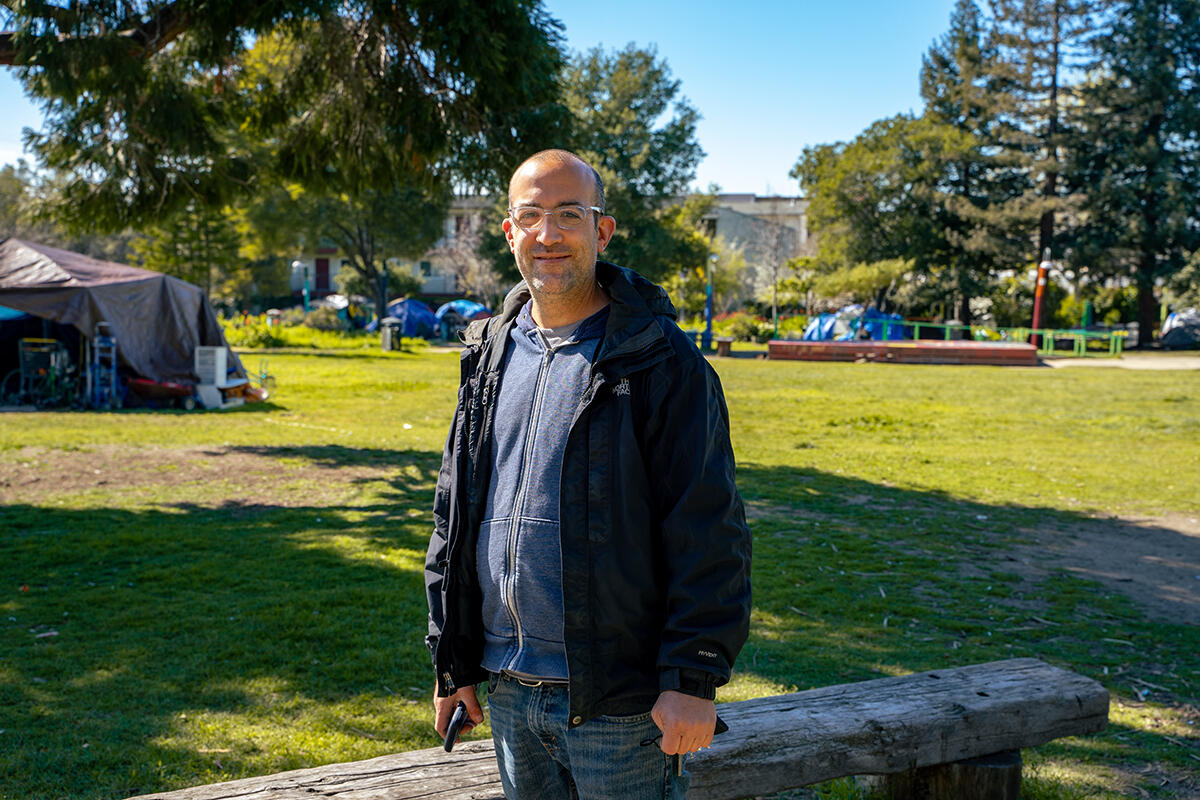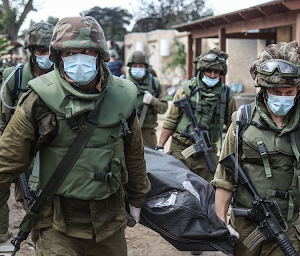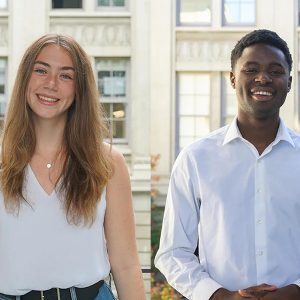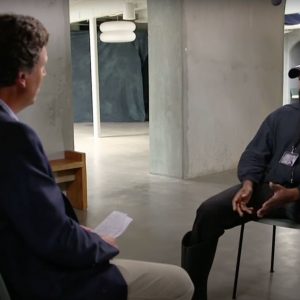This interview with UC Berkeley’s Homelessness Outreach Coordinator Ari Neulight was conducted before the university announced a comprehensive housing plan for the current People’s Park residents on March 9th. We hope that a conversation with Mr. Neulight will shed light on the homelessness crisis around the campus and the numerous obstacles that unhoused people in and around the park are confronted with. We want to highlight the dilemmatic challenges that the university has been facing, especially the severe lack of student housing and the revamping efforts against the redevelopment of People’s Park, and the maze of bureaucracy that social workers and the unhoused need to navigate on a daily basis. This interview has been condensed and edited for length and clarity, and this is the first part of a two-part series on People’s Park.
Mr. Neulight has been working as the Homelessness Outreach Coordinator at UC Berkeley since July 2017. He graduated from UC Berkeley with a Bachelors’s in Psychology in 1996. He then received an MS in Psychology from the University of Wisconsin-Madison, and an MSW in Social Work from San Francisco State. He has over 25 years of social service experience, including nearly 20 years working with people who are currently or formerly experiencing houselessness.
What led to your interest in social service? How long have you been working as a homelessness outreach coordinator?
I have always done social service work since I started working. When I was a student at Cal in the early 1990s, I used to volunteer at Lincoln Child Center to work with children with behavioral and emotional challenges. In my sophomore and junior years, I interned at Napa State Hospital to do social service work. I have been working with people who struggle with housing issues for the last 17 years. I have been working as a homelessness outreach coordinator since July 2017. It was a new position when I started working.
What was your major when you were an undergraduate student at Cal?
Psychology (laugh). I did not know what major I wanted to pursue initially and I had enough course work in that area. But I was interested in many subjects beyond psychology. I did a senior project on anthropology and psychology. I did a project on social welfare and the mental health system. I took a lot of courses on philosophy.
What led to the establishment of your position?
The chancellor and the mayor of the City of Berkeley at the time were interested in cooperating to handle common challenges. Two of the challenges were housing and homelessness. Sam Davis, a special advisor to the chancellor on homelessness issues, suggested creating a position that would both support student learning and strengthen the existing outreach team to assess the needs of the homeless population specifically on the south side.
Compared with the 1990s, when you were a student at Cal, do you think homelessness has been getting worse?
I don’t think I was fully aware of the issue of homelessness and housing at the time. I do know that in general, things have been getting worse.
Has gentrification contributed to the worsening of the homelessness crisis in Berkeley?
Yeah, you can say gentrification. But I would say that the stagnation of wages has also contributed to the current homelessness crisis. Wages are not really staying at pace with the increase of housing costs. Affordable housing has been lacking and the funding for affordable housing is not really at the levels to meet the needs of the community. There are larger structural issues that plague not just Berkeley but the entire Bay Area and beyond. I think that is what makes things worse.
How many people are living in People’s Park currently?
There are around 55 people who are sleeping there. There are about 70 tents in the park, but that does not necessarily mean that 70 people are sleeping in the park. Some tents are abandoned. A lot of tents are used for storage. Some people no longer live there but keep their tents in the park in case they need to come back or just abandon them.
How many residents in the park need addiction treatment?
I think people generally have a good idea of what they need in terms of services. Most of my conversations with people are not revolving around addiction treatment. Actually very few of them want to go into treatment. The model that we tend to use prioritizes housing (“housing first”). Let’s try to bring folks into housing. Once people are housed and experience stability, you will start to witness progress. We don’t want people to be forced to prove that they are ready for housing. The second thing that we do is harm reduction. We continue to look for opportunities to reduce harm and increase safety in terms of substance use or misuse. We have regular conversations with people who use substances, and those conversations are more meaningful than simply asking people to go into addiction treatment.
What harm reduction-related services are you providing? Such as distributing clean needles?
Sure. We partner with other organizations to hand out clean needles, condoms, and other supplies. We work with organizations such as Lifelong to ensure that people have the support that they need. We also set up syringe disposal devices in the bathroom of People’s Park.
What is the procedure that a homeless person needs to go through if they want to get housing?
Housing is really complicated (laugh). I think the complexity of getting housing is related to the way the system works now. First, I would try to have some conversations with people to assess their situations and understand their needs. Then I would refer them to a city or county-contracted assessment entry point. Every county is required to assess individual needs, prioritize resources towards those most in need, and collect data on their homeless populations– which is a precondition for their eligibility for relevant federal funding. The City of Berkeley (North County region) contracted out the assessment work to non-profit workers to assess the vulnerability of each unhoused individual or family that requests housing assistance. Depending on the conversations that they have, they determine the next step. For someone who has been homeless for a long time and has a lot of vulnerabilities that the system identifies, there might be opportunities for them to receive either a voucher or a site-based option that offers affordable housing.
There are also people who have fewer vulnerabilities and have jobs, and for them, there are other available options–and they need to go through the assessment process as well. There are shelter options as well. We also help people to get on waiting lists for housing. And we help brainstorm if there are any other people they can live with. Most people that we have served through my work have gone through the county process. It took a while to get things going, but probably over the three and a half years or so, we have helped about 100 households get housed. There are another 30 people or so who are either on a waiting list for housing or are waiting to be matched to a housing option (who stay in or around the park).
Are you suggesting that the homeless population in the park is dynamic? Meaning that they come and go?
Yes. For example, people who stayed here before the pandemic are different from the people who are currently living in the park. There is very little overlap. It is a dynamic population. At this time, the park is the only location in Berkeley that is not enforcing the law against camping overnight. There are people who have stayed in the park, on and off, over many years. There are also people who continue to come. I don’t think homelessness is a People’s Park issue per se. It’s a larger societal issue. I wouldn’t say that the numbers are endless, but in a way they kind of are. The problem is so big and yet I hold on to hope for the impact we can have.
When I interviewed Vice Chancellor Mongulof, he elucidated that the university would launch the People’s Park housing project in summer 2022. Do you think the school can house every current resident by summer?
There will be transitional housing for current park residents. The university made a commitment to support everyone currently staying at the park to have some sort of transitional housing that is tied to permanent housing opportunities. Chancellor Christ said that the construction would not begin until we are able to offer that.
So the university has promised to put people into transitional housing, but not necessarily permanent housing.
Well, I don’t think the university itself has the capacity to provide permanent housing to everyone in the next few months. The opportunity is that people have a place to stay until they find permanent housing. Finding permanent housing can take months and months, even years. There is a process. It takes a few years for me to get someone into permanent housing. It’s very complicated. But this new opportunity will put everyone on a pathway to housing with lots of support for success alongside community and government partners.
(Author’s Note: The City of Berkeley and UC Berkeley has jointly announced a plan to rent Rodeway Inn to house the current People’s Park residents, which was previously used to provide interim housing to those who had been living in the encampment adjacent to the University Avenue interchange on Highway 80. The cost of the project will exceed $6 million, will be partially paid for with a $4.7 million grant from the State of California’s Encampment Resolution Fund and approximately $2.2 million from the university.)
Practically speaking, I assume that the university wants to stop the inflow of homeless people into the park at the moment. If the university does not have a plan in place to stop the inflow, how would it be able to start the construction in the summer?
I understand what you are saying, and I don’t think there is any plan in place to stop the inflow. I am curious about what you think. What would that look like?
Li: Obviously, there needs to be some sort of deterrence.
Neulight: I guess. But what would that look like?
Li: It would not look good.
Neulight: In any case, we try to support people the best way we can. We plan to be sure to prioritize those currently at the park while also working alongside the city to support people in the best way we can based on opportunities and what works for folks.
If the university starts the construction of student housing on the park’s land, do you think the homelessness crisis around the campus will improve or deteriorate?
This is a neighborhood that historically has many people coming together, and I don’t see the homelessness issue being solved by a single project. I think a comprehensive, sustainable, long-term solution with deep partnering will continue to be important in the district and that these projects will greatly support the community.
What are some of the biggest challenges that you face as a homelessness outreach coordinator?
I would say that the system can be very difficult to work with sometimes. Whether trying to get disability benefits or housing, these things take a long time. Helping people to navigate the system is half of my job. The other challenge is time. There are a lot of students and people from the community who have been helping out, but sometimes I wish there were more people who were designated to work with homeless people. This model of having a point-of-contact person is kind of new for Berkeley, and they extended it to downtown Berkeley following the success in the Telegraph area. It breaks my heart when people can’t get the resources they need because they don’t have access to information or know someone who can help them navigate the system because they are not in an area where workers like me are available. If you don’t have access to someone like me, you might end up missing out.
Li: So there is a disparity of information regarding how to navigate the system.
Neulight: I think so. Someone might be able to get more information and access to services around the park than they do in other places in Berkeley. While we focus a lot on the park, since it’s close to the campus and it’s central, I hope there can be more resources to support people outside the park in the broader community. Lastly, a large gap in resources, particularly those related to housing to match the great need and interest. Housing can be difficult to navigate and is nowhere near the level of need. We need more permanent supportive housing, more affordable housing….way more. People are so desperate for safe, affordable housing near the communities they know and are connected to.
Correction: In a previous version of this article, we erroneously stated that the University and City of Berkeley purchased Rodeway Inn. The hotel will be rented according to the University’s plan.
Featured Image Source: UC Berkeley










Comments are closed.